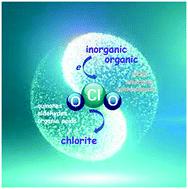当前位置:
X-MOL 学术
›
Environ. Sci.: Water Res. Technol.
›
论文详情
Our official English website, www.x-mol.net, welcomes your
feedback! (Note: you will need to create a separate account there.)
The reactions of chlorine dioxide with inorganic and organic compounds in water treatment: kinetics and mechanisms
Environmental Science: Water Research & Technology ( IF 3.5 ) Pub Date : 2020-07-15 , DOI: 10.1039/d0ew00231c Wenhui Gan 1, 2, 3, 4, 5 , Yuexian Ge 1, 2, 3, 4, 5 , Yu Zhong 1, 2, 3, 4, 5 , Xin Yang 1, 2, 3, 4, 5
Environmental Science: Water Research & Technology ( IF 3.5 ) Pub Date : 2020-07-15 , DOI: 10.1039/d0ew00231c Wenhui Gan 1, 2, 3, 4, 5 , Yuexian Ge 1, 2, 3, 4, 5 , Yu Zhong 1, 2, 3, 4, 5 , Xin Yang 1, 2, 3, 4, 5
Affiliation

|
Chlorine dioxide (ClO2), as an alternative to chlorine, has been widely applied in water treatment. In order to better understand the performance of ClO2 in water treatment, the kinetics and mechanisms of ClO2 reactions with inorganic and organic compounds found in waters are critically reviewed. In the case of inorganic compounds, ClO2 reacts with I−, CN−, NO2−, SO32−, Fe(II) and Mn(II) rapidly at apparent second-order reaction rate constants (kapp) of 102–106 M−1 s−1 at pH 7.0 and barely reacts with NH4+ and Br−. In the case of organic compounds, ClO2 selectively reacts with compounds with electron-rich moieties, such as phenols (kapp = 103–109 M−1 s−1), anilines (kapp = 105–108 M−1 s−1), and thiols (kapp > 108 M−1 s−1). ClO2 also shows high reactivity towards aliphatic tertiary amines and heterocyclic nitrogenous compounds (i.e., indoles and piperidines) with kapp of 101–106 M−1 s−1 at pH 7.0, but low reactivity with unsaturated structures (i.e., olefins and aldehydes). The kapp values at pH 7.0 in ClO2 oxidation vary over 14 orders of magnitude. Electron transfer is the dominant pathway for ClO2 reactions. Quantitative structure–activity relationships (QSARs) can be used to predict the species-specific secondary reaction rate constants for ClO2 oxidation of compounds containing phenolic and amine structures. Little modifications are expected on the structure of the parent compounds upon the primary attack of ClO2, but further oxidation generally leads to the formation of quinones, aldehydes and carboxylic acids. Furthermore, the transformation kinetics of inorganic compounds, typical organic compounds and emerging micropollutants are compared and their half-life times under typical water treatment conditions during ClO2 oxidation are calculated.
中文翻译:

水处理中二氧化氯与无机和有机化合物的反应:动力学和机理
作为二氯的替代物,二氧化氯(ClO 2)已广泛应用于水处理中。为了更好地理解CLO的性能2水处理,CLO的动力学和机制2反应与无机和有机化合物在水中发现的严格审查。在无机化合物的情况下,CLO 2种发生反应与I -,CN -,NO 2 -,SO 3 2-,Fe(上II)和Mn(II)迅速在表观二级反应速率常数(ķ应用程式的)10 2 –10 6 M-1小号-1,pH为7.0和勉强NH反应4 +和Br - 。对于有机化合物,ClO 2与具有高电子部分的化合物(例如苯酚( k app = 10 3 –10 9 M -1 s -1),苯胺( k app = 10 5 –10 8 M)选择性地反应-1 s -1)和硫醇( k app > 10 8 M -1 s -1)。CLO 2还示出了对脂族叔胺和杂环含氮化合物(高反应性,即用,吲哚类和哌啶)ķ应用程式10 1 -10 6中号-1小号-1,pH为7.0,但反应性低与不饱和结构(即,烯烃和醛)。所述ķ应用在CLO在pH 7.0的值2氧化变化超过14个数量级。电子转移是ClO 2反应的主要途径。定量构效关系(QSAR)可用于预测ClO 2的物种特异性二级反应速率常数氧化含有酚和胺结构的化合物。在ClO 2的初次攻击下,预期对母体化合物的结构几乎没有修饰,但是进一步的氧化通常导致醌,醛和羧酸的形成。此外,比较了无机化合物,典型的有机化合物和新兴的微污染物的转化动力学,并计算了它们在ClO 2氧化过程中典型水处理条件下的半衰期。
更新日期:2020-08-27
中文翻译:

水处理中二氧化氯与无机和有机化合物的反应:动力学和机理
作为二氯的替代物,二氧化氯(ClO 2)已广泛应用于水处理中。为了更好地理解CLO的性能2水处理,CLO的动力学和机制2反应与无机和有机化合物在水中发现的严格审查。在无机化合物的情况下,CLO 2种发生反应与I -,CN -,NO 2 -,SO 3 2-,Fe(上II)和Mn(II)迅速在表观二级反应速率常数(ķ应用程式的)10 2 –10 6 M-1小号-1,pH为7.0和勉强NH反应4 +和Br - 。对于有机化合物,ClO 2与具有高电子部分的化合物(例如苯酚( k app = 10 3 –10 9 M -1 s -1),苯胺( k app = 10 5 –10 8 M)选择性地反应-1 s -1)和硫醇( k app > 10 8 M -1 s -1)。CLO 2还示出了对脂族叔胺和杂环含氮化合物(高反应性,即用,吲哚类和哌啶)ķ应用程式10 1 -10 6中号-1小号-1,pH为7.0,但反应性低与不饱和结构(即,烯烃和醛)。所述ķ应用在CLO在pH 7.0的值2氧化变化超过14个数量级。电子转移是ClO 2反应的主要途径。定量构效关系(QSAR)可用于预测ClO 2的物种特异性二级反应速率常数氧化含有酚和胺结构的化合物。在ClO 2的初次攻击下,预期对母体化合物的结构几乎没有修饰,但是进一步的氧化通常导致醌,醛和羧酸的形成。此外,比较了无机化合物,典型的有机化合物和新兴的微污染物的转化动力学,并计算了它们在ClO 2氧化过程中典型水处理条件下的半衰期。











































 京公网安备 11010802027423号
京公网安备 11010802027423号